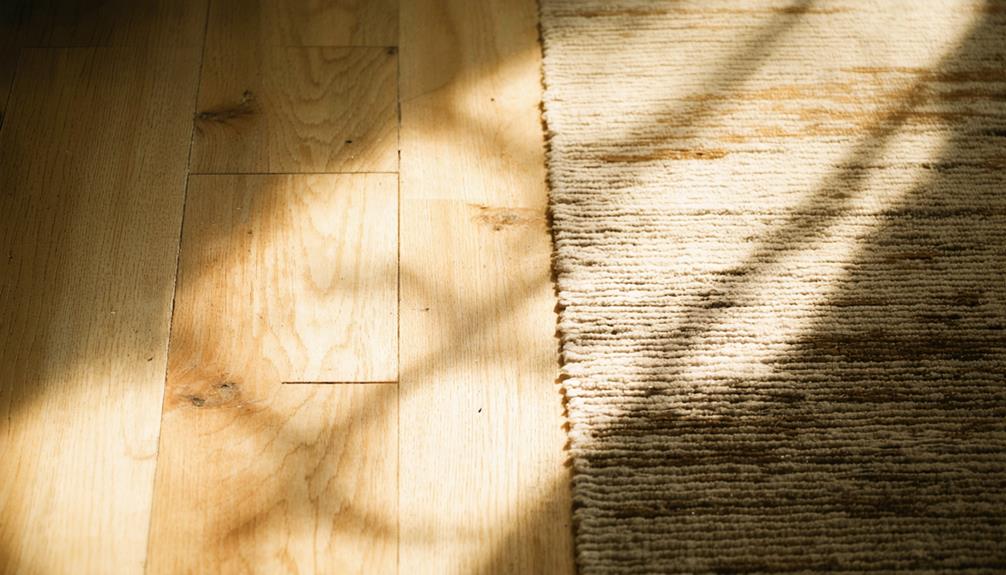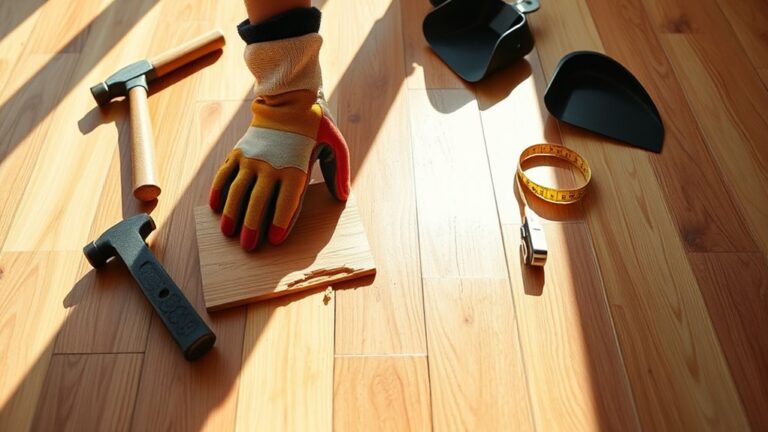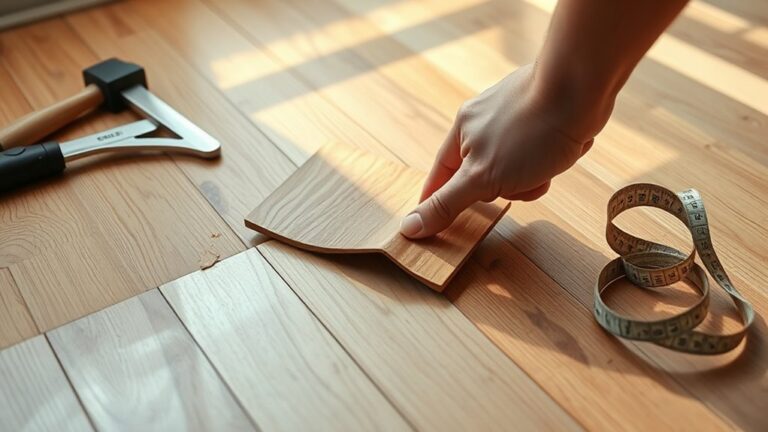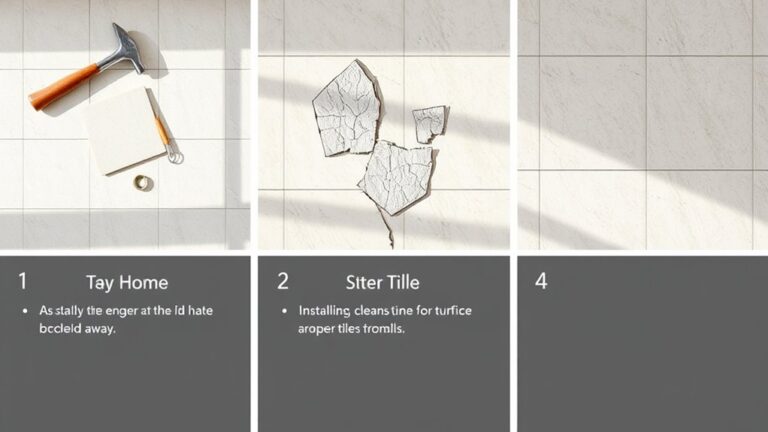If you notice deep scratches, water stains, or persistent odors, it's time to reflect on replacing your flooring. Look for soft spots underfoot, as they can indicate hidden moisture issues. Excessive wear in high-traffic areas reveals your flooring's lifespan is coming to an end. Also, listen for squeaks or creaks; they often signal structural problems needing urgent attention. Aging materials may emit VOCs, aggravating allergies and health concerns. Don't wait until the damage escalates. Exploring expert consultation can provide tailored solutions for your specific flooring needs, ensuring a lasting and healthy environment in your home.
Visible Damage and Wear
When it comes to flooring, visible damage and wear can be clear indicators that it's time for a replacement. If you notice deep scratches, cracks, or tears in your laminate or vinyl flooring, it's imperative to assess the situation. These signs not only diminish the aesthetic appeal of your home but can also pose safety risks.
Discoloration is another key factor. Significant fading or extensive stains suggest that your flooring has reached a point where cleaning or refinishing won't restore its original look. If you find yourself dealing with water damage, characterized by bulging, dark stains, or warped boards, it's important to act quickly. Such damage can compromise the integrity of your flooring and necessitates urgent replacement to prevent further issues down the line.
Lingering odors, particularly those from trapped moisture or mold, signal degradation of your flooring material. In these cases, replacement is often more effective than mere cleaning efforts. Additionally, high traffic areas showing excessive wear or matting are strong indicators that your flooring has reached the end of its lifespan.
Ultimately, recognizing these signs of wear and damage is significant for maintaining a safe and visually appealing environment. If you're experiencing any of these issues, it's time to evaluate replacing your flooring to restore the beauty and functionality of your space. Don't wait until the problems worsen; take charge of your home's flooring today.
Water and Moisture Issues
Water damage can wreak havoc on your flooring, leading to serious structural and aesthetic issues that often require immediate attention. If you notice any signs of water-damaged flooring, it's vital to act fast. Prolonged moisture exposure can not only compromise the structural integrity of your floors but also pose significant health risks.
Here are some key indicators that it might be time for a replacement:
- Dark spots or stains: These can signal hidden moisture issues beneath your flooring.
- Bulging boards: Warping or swelling is a clear sign of consistent moisture exposure affecting wood planks.
- Soft spots: If you feel any give when walking on hardwood or engineered timber, it's time to inspect for water damage.
- Mold and mildew: Carpets and vinyl are particularly susceptible to fungal growth when exposed to moisture, necessitating replacement.
- Vacuumed floors: If your vacuum struggles on certain areas, it may indicate underlying water issues.
Ignoring these signs can lead to irreversible damage and increased costs associated with repairs or replacements. Water-damaged flooring not only detracts from your home's aesthetic but can also create unsafe living conditions. Don't wait until it's too late; by recognizing the signs that it's time to replace your flooring, you can guarantee your home remains safe, healthy, and beautiful.
Noise and Structural Concerns
Over time, you may begin to notice unsettling noises emanating from your floors, such as squeaks and creaks that signal potential structural issues. These sounds often indicate loose floorboards, which can compromise the structural integrity of your home. If left unaddressed, persistent noise may suggest significant underlying problems, including rotting or damage to the subfloor. This necessitates a thorough inspection to determine whether flooring replacement is needed.
Excessive noise can also arise from improper installation or inadequate underlay, leading to discomfort and dissatisfaction in your living space. Ignoring these issues can result in further deterioration, escalating repair costs down the line. If you're experiencing increasing noise levels, it might be time to contemplate upgrading your flooring materials to those designed for better sound insulation.
Addressing noise concerns early on not only protects your home's structural integrity but also enhances your overall living experience. You deserve a space that feels secure and comfortable. By opting for newer flooring options that prioritize acoustic compliance, you can mitigate the persistent noise that disrupts your peace.
Don't wait until the situation worsens. A proactive approach, including a professional inspection and timely flooring replacement, can save you from more extensive and costly repairs in the future. Take charge of your home environment and guarantee it remains a sanctuary of freedom and tranquility.
Health and Allergy Impacts
Often, the condition of your flooring can greatly affect your health and well-being, particularly if you suffer from allergies. If you've noticed increased allergy symptoms or respiratory issues, it might be time to think about replacing your flooring. Carpeted floors can trap dust, pollen, and pet dander, leading to allergen accumulation that worsens indoor air quality. Additionally, mould and mildew can thrive in moisture-absorbing materials, posing serious health risks and necessitating replacement.
Here are some indicators that your flooring's health and allergy impacts warrant attention:
- Normal wear: Over time, flooring can degrade, making it less effective at trapping allergens.
- Poor installation: If your flooring was improperly installed, it could facilitate the growth of allergens and mould.
- Volatile organic compounds (VOCs): Aging materials may emit VOCs, which can aggravate allergies and contribute to health problems.
- Ineffective cleaning: Regular cleaning may not eliminate accumulated allergens, indicating that replacement is necessary.
- Hypoallergenic options: Switching to hard surface flooring like tile or vinyl can greatly reduce allergen accumulation, promoting better air quality.
Prioritizing your health means recognizing when it's time to replace your flooring. By opting for hypoallergenic flooring solutions, you can create a more comfortable living environment that supports your well-being and minimizes allergy triggers. Don't hesitate to take action; your health is worth it.
Expert Consultation and Installation
If you're considering replacing your flooring to improve indoor air quality and reduce allergens, seeking expert consultation can greatly enhance your decision-making process. Flooring experts provide tailored recommendations that account for your home's specific needs, helping you choose the right material and style for both longevity and aesthetics. With an array of flooring options available, their insights can guide you toward solutions that best suit your lifestyle.
Professional installation is essential, not only to validate manufacturer warranties but also to guarantee adherence to product specifications. Without it, you risk compromising your investment. Experts can identify underlying issues like subfloor damage or moisture problems that may require attention before new flooring is installed, preventing future complications.
When you utilize professional installers, you gain access to their experience and specialized tools. They can adeptly navigate complexities such as uneven surfaces and guarantee acoustic compliance, which is particularly important in multi-level homes or shared spaces. Many advanced flooring products come with stringent installation guidelines that necessitate precision; expert installation minimizes the risk of visible imperfections and enhances durability.
Frequently Asked Questions
How to Know if a Floor Needs Replacing?
To know if your flooring needs replacing, inspect for deep scratches, cracks, or water damage, as these can compromise your flooring materials. Consider installation tips that highlight the importance of noise reduction and pet-friendly choices. If you notice persistent odors or excessive noise, it's time to review cost considerations versus DIY projects. Staying updated on design trends and eco-friendly options can also guide your decision when evaluating seasonal care and maintenance practices.
When Should Flooring Be Replaced?
When should you replace your flooring? Imagine walking on a surface that's more like a roller coaster than a floor! If you're facing constant maintenance hassles or the aesthetic updates feel like a lost cause, it's time. Consider cost, noise reduction, and health concerns; outdated flooring can impact your home's resale value. Explore DIY options, but remember, professional installation techniques often guarantee longevity and reduce environmental impact. Don't wait; breathe new life into your space!
What Is the Average Lifespan of Flooring?
When considering flooring materials, it's essential to know their average lifespans. Carpets last 7 to 10 years, while hardwood can last 20 to 100 years with good maintenance. Vinyl typically ranges from 10 to 20 years. For durability, tile flooring shines, lasting over 50 years. By following maintenance tips, such as proper cleaning techniques, you can enhance longevity. Don't forget to explore eco-friendly options and style trends that match your color choices and sound insulation needs.
How to Tell if Your Floor Is Bad?
When you step onto your floor, it should feel solid and safe, not a source of concern. Look for flooring inspection tips: signs of damage include water damage indicators like dark spots and mold growth signs. Pay attention to pet-related issues, scratching and dents, and discoloration patterns that resist cleaning. Squeaky floorboards and uneven surfaces signal deeper problems. If these issues arise, it's time to evaluate your flooring's integrity for your peace of mind.




